This a guest blog from Vinay Bhaskara looking how airline and train transportation has changed over time on the east coast. This is his story:
One of my more ’œavgeeky’ hobbies is looking at the Form 41 data; specifically the T100. The T100D Segment, which I’m going to be looking at today, gives us data about every domestic flight operated by all carriers, both US owned, and international.
Now the T100 database at the DOT goes back to 1990, so I decided to take a look at how a specific route looked like in 1990, and then in 2009 (the second to last full year of data available). After a few moments of debate, I decided on New York La Guardia to Washington Reagan ’“ one component of the venerable Northeast Shuttle.
The La Guardia to Reagan route is still one of the most traversed air routes in North America, comprising 423,483 passengers last year. There are only two airlines on the route; US Airways, and Delta. In 1990, it was the legendary Pan Am who flew the route in lieu of Delta. That being said, here are some of the stats I found most interesting:
* Capacity on the route fell by 49% and passengers dropped 50%. So in 19 years, the airlines have halved their capacity on the route, and half as many passengers are flying the route.
* Despite the precipitous drop in capacity and demand, the average number of daily flights only dropped from 31 to 24.
* This corresponds with the average aircraft size falling from 159 seats in 1990, to 103 seats in 2009. Of course this probably has a lot to do with the fact that Delta is running E175s every hour, but still.
* Delta had a load factor of 40% last year. I hope they have lots of high yielding passengers, because they sure as heck aren’t filling many seats.
The following chart shows how the capacity and passengers carried stacked up for each airline:

The next two charts show the corresponding market shares of the different airlines. Isn’t it surprising that Delta (who replaced Pan Am on the route in 1991) lost so much market share?

Why are the passenger numbers dropping so much? In a word: time. The time it takes to fly between New York and DC has grown so much, that flying has become far less attractive, especially when compared to other options like the Acela Express.
Still skeptical?
Let’s take our average businessman, and say that he lives 20 minutes away from both Penn Station and La Guardia (I’m not sure there is such a point, but work with me here). So we start with that. Then, the Acela Express takes an average of 3 hours to reach its destination, and bam, you’re in downtown DC at Union Station.
The flight on the other hand is much more complex. After arriving at the airport, you usually have to budget time for security. I’d estimate it to be 15 minutes at the Marine Air Terminal (Delta Shuttle) during peak times, and 40 minutes at US Airways’ terminal during the same time period. So let’s assume that it takes around 30 minutes for security. Then, you want to be at the gate around 25 minutes before your flight; which brings you to a total of 75 minutes before you even board the flights. Now, the average ramp to ramp time, which is how long it takes for the plane to go from gate to gate was 73 minutes last year. Once you arrive at the airport, we can figure around 10 minutes for disembarking and going to the taxi stand/limo pickup. From Reagan National, it usually takes around 25 minutes to get to downtown DC by car. So let’s tally up the total travel time for each method.
Acela Express
Drive to Penn Station- 20 minutes
Train Travel Time- 180 minutes
Total Travel Time- 200 minutes
US Airways and Delta Shuttles
Drive to La Guardia- 20 minutes
Security at Airport- 30 minutes
Time at Gate Prior to Departure- 25 minutes
Plane Travel Time- 73 minutes
Time to Get out of Reagan Airport- 10 minutes
Drive to Downtown DC- 25 minutes
Total Travel Time- 183 minutes
Plus, the service on the Acela Express is much better. Acela Express- Spacious seats, in-seat power, WiFi, a newspaper, and gourmet meals. US Airways/Delta Shuttle- Cramped cabin, snack boxes, free drinks, and a newspaper. You decide’¦.. Which one would/do you choose?
Vinay Bhaskara is an aviation analyst and history buff based in the United States (New Jersey). In addition to his analyst’s position at Aspire Aviation, he also writes for the Bangalore Aviation blog, and does a podcast on Asian aviation with Innovation Analysis Group (IAG). He can be reached at @TheABVinay on Twitter, as well as at vi***@ba***************.com, on Facebook , and via Linkedin.
Temo Madrigal is a good friend and is a correspondent for my blog. He also is not loyal to any one airline and normally tries to find the best deal possible, especially when flying with his wife and three kids. Recently he had a flight by himself from Seattle (SEA) to Indianapolis (IND) with a layover in Minneapolis (MSP) on Delta Air Lines. I asked if he could check out the SkyClub during his four hour layover in MSP and give his honest impressions since he had never been in an airline lounge before. He agreed.
The SkyClub located at the entrance of the F and G concourses at MSP (there is another located on the C concourse) is Delta’s busiest club after Atlanta and takes up about 12,500 square feet. The club was re-done in January 2011 as part of Delta’s more than $2 billion investment in airport facilities and global products, services and technology upgrades. Here is Temo’s experience in his own words:
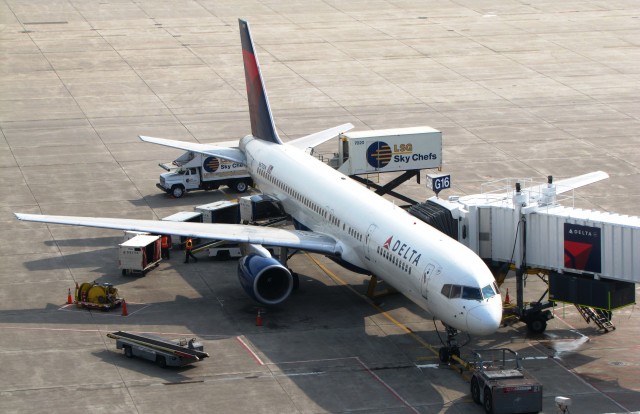
Delta Air Lines Boeing 757-200 at MSP. Photo by Daniel Betts.
Some of my fellow travelers like to book their flights direct with no stops. I, on the other hand am all about saving money, even if it’s a measly twenty dollars. As a stay-at-home-dad, I like to enjoy the few hours I spend alone in the sometimes-busy airport terminals. Don’t get me wrong, I love my kids, but getting to read more than one chapter of a book in one sitting is a rare treat.
Recently, I was traveling to the Midwest and had a four-hour layover in Minneapolis and the Airline Reporter (aka David) asked me to check out the Delta Sky Club and provide readers with an inside look at the amenities of the club and if a one day pass (normally $50) would be worth it.
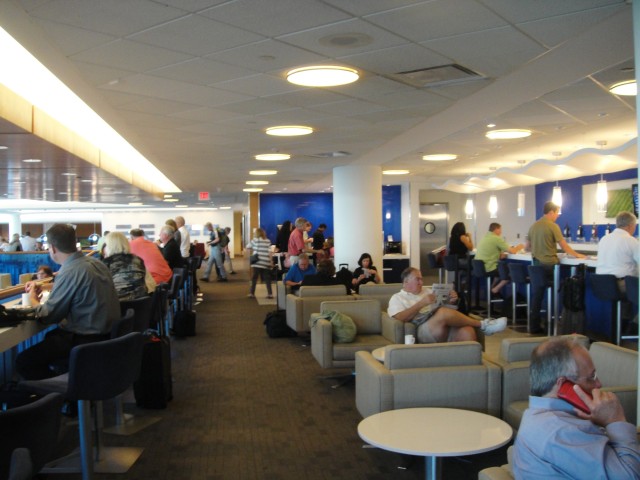
Delta Lounge
The Delta Sky Club in Minneapolis was formally the Northwest Airlines Worldclubs and is one of the oldest lounges in the Midwest. One wouldn’t be able to tell since it was first updated during the merger of Delta and Northwest in 2008 and then again January of this year.
Honestly, before seeing the Delta Sky Club, I had never actually been in an airport lounge. In my mind I had imagined dark painted walls, black ceilings, old style leather couches, and maybe even a stuffed moose head on a wall over the bar. I usually travel with a child or two in-tow, so running up and down the terminal is something that we do to tire-out our kids and help them be less of a hassle on the plane (mostly to respect our fellow travelers), and due to my vivid imagination and ideas of what an airport lounge includes, I never looked into them. This trip had definitely helped me change my mind.
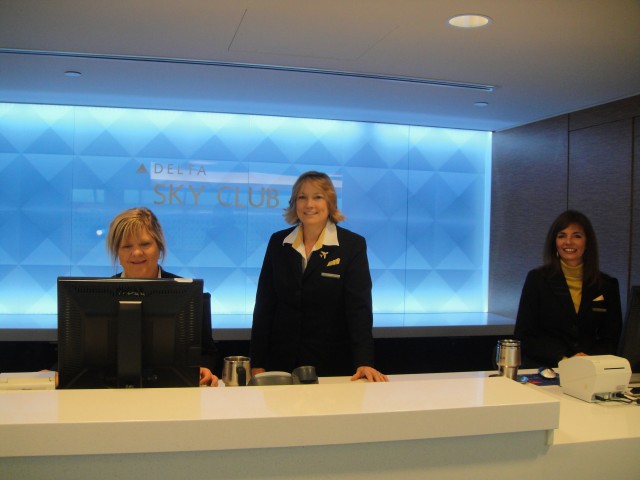
A good club takes more than just a comfy place to sit -- it takes good staff and Delta delivers.
The foyer of the Delta Sky Club looked inviting and the young ladies at the reception desk welcomed me with genuine smiles and some humor. Something you might not see at every airport establishment at 6:10 AM. I was quickly asked if I had ever been to the Minneapolis club and if I needed any assistance with the services. I let them know that I had not and one representative provided me with a brief tour of the club and the amenities that are offered. I quickly realized that there was no moose head and my ideas of what I would find were completely the opposite.
The entire lounge was actually had a retro-yet-new-feel with florescent lights dimmed by blue stained glass, both the furniture and artwork were a cross between modern and art deco that gave the entire lounge a chic and upscale look and feeling. Being in the club actually made me feel as if I had entered an exclusive nightclub, but yet somehow I belonged.
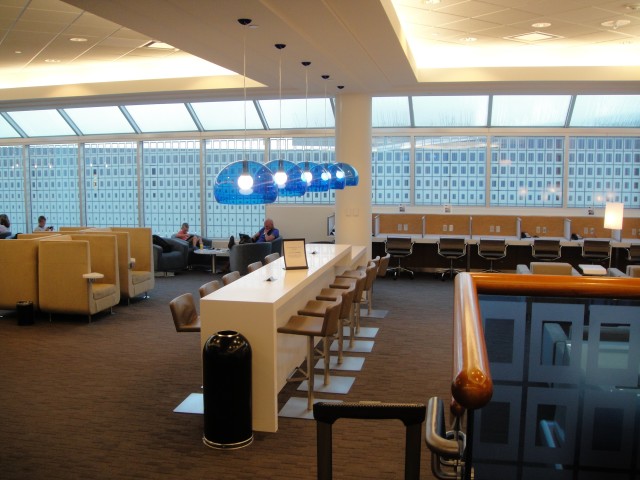
Delta's SkyClub in MSP has lots of different seating options.
After the brief tour I decided to use the amenities of the lounge. First, was the men’s room and I was a little disappointed. Being that I was on a red-eye and had a full day ahead of me, I was hoping that there would be showers at this location, but there were not. I felt awkward having to brush my teeth in sinks that were directly located in front of bathroom stalls for some reason. At least the restroom was very clean, so it that wasn’t a big deal.
The good part is most people won’t spend most of their time in the bathroom. The seating areas were outstanding, with the two level lounge being open and ample. There were a variety of seat options ranging from nest style seats that provided some privacy, full reclining chairs, living room style seating arrangements with coffee tables at the center, and bar table and stool seats as well. It also featured a ’œquiet area’ that was in a sunken nook style space in the far corner of the club with full reclining chairs.
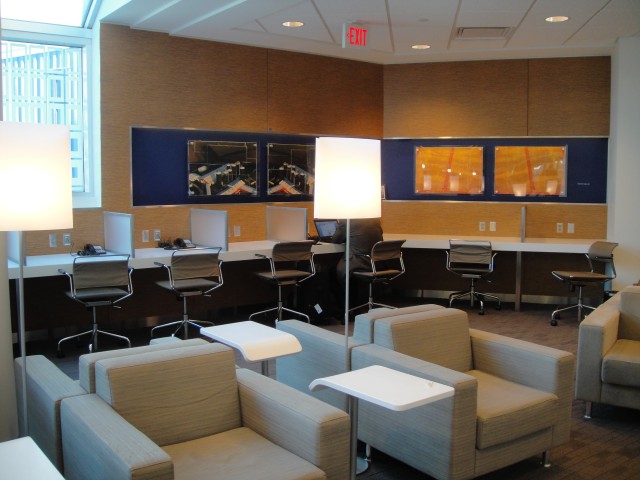
One can sit and relax or get down to business in the SkyClub.
The business office area offered both desks with internet hook-up and telephones, as well as desks with ready-to-use desktop computers, printers and a fax machine. I was able to use the free Wi-Fi with my tablet after being helped by the reception desk. There is also satellite TV available, but if you are looking for non-electronic entertainment, you can find plenty of daily newspapers (Wall Street Journal, USA Today, New York Times, etc.) and magazines.
The Delta Sky Club offers what Delta calls ’œSnacks Served All Day’. I perused the continental breakfast selections; oatmeal with the trimmings, bagels, trailmix, fresh fruits, cereal, yogurt, and a multi-selection beverage dispenser that offered coffee, tea, and hot cocoa. I’m a Seattle coffee drinker and give kudos for the strong coffee that came out of the dispenser.
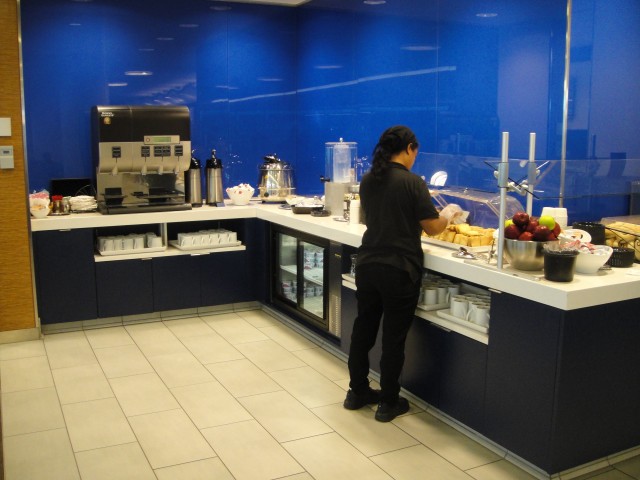
There might not be a ton of food an drink options, but you can have as much as you want.
The bar was stocked with complimentary premium wines, beer and liquor. Again, there was no moose head over the bar, but there were three large plasma televisions offering both news and sports options for patrons to watch, and now that I think about it, it’s definitely better than having to stare at a dead moose head for four hours. The bar was clean, attractive, and the bartenders, Taslfalem and Sebele, were polite and very attentive. Both were able to multi-task by holding a great conversation and do their work with precision and a smile.
When heading back to Seattle and stopping at Detroit, I was offered a one-day pass to the Delta Sky Club for only $39.00. I had a four-hour layover once again and sitting with the “normal” people just didn’t seem appealing. I wanted to see the difference of how much money I would spend normally on food, drinks, etc. at the airport. I spent a total of $29.17 for an appetizer and two drinks in a bad Mexican restaurant with uncomfortable chairs. For ten dollars more (even for $20 more at the standard $50 price) I could have had the same positive experience I had in Minneapolis at the Delta Sky Club.
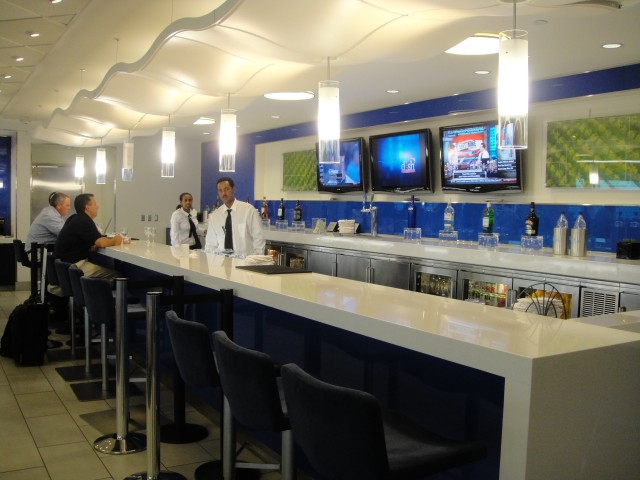
The bar was my favorite place. Good drinks and great conversation.
So is the cost of a day pass or even a yearly membership worth it? Well, I met a gentleman at the Sky Club Bar that mentioned he had become a member of The Delta Sky Club (formally Delta Crown Room Clubs) almost fifteen years ago because he wanted to find a better place for his kids to have a soda and relax during 2-4 hour layovers. He is a loyal member and feels that it only keeps getting better. I have to agree. It will be pretty hard for me not to have lounge access, but I do not travel enough for a yearly membership. Delta better believe they might see me a time or two using a day pass in the future, which is a big statement coming from a conservative spending guy like me.
B757 image by Daniel Betts
All others by Temo Madrigal
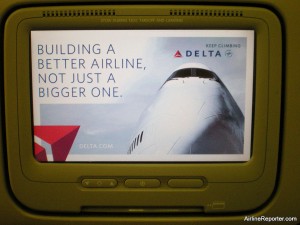
Delta ad on one of their seatback video displays.
On Monday, Delta Air Lines announced a new level of service coming to long-haul international flights: Economy Comfort. By summer 2011, more than 160 of Delta’s Boeing 747, 757, 767, 777 and Airbus A330 will have the new Economy Comfort seats installed. The seats themselves aren’t that much of a change, but what comes with them is a pretty a nice improvement. The seats will give you four more inches of legroom and 50% more recline, but you are also going to get free drinks and premium boarding.
The obvious comparison is to United Airline’s Economy Plus. United flies Economy Plus on international and domestic flights and it has been a great way to create loyalty for their passengers.
To learn more and see a great comparison chart between Economy Comfort and Economy Plus, check out Brett Snyder’s blog, Cranky Flier.For some photos and even more information, check out Dan Webb’s blog, Things in the Sky.
There is strong competition between the world’s two largest airlines and it looks like Delta has just played their hand. United… it is your move.
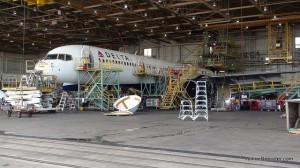
A Boeing 757 with its nose off in for work at Delta Tech Ops. Click for larger.
You hear a lot of complaints from folks about companies outsourcing. In fact, its known within the airline community that many airlines not do their own maintenance. Delta Air Lines works just the opposite. Not only do they not outsource their maintenance, but they also in-source work from other companies from around the globe.
Delta’s Technical Operations (TechOps) is located on the west east side of the airport and is about 1.5 miles long. My tour guide, Anthony Black, thankfully opted for a golf cart, since we had a lot of ground to cover.
Hartsfield’“Jackson Atlanta International Airport (ATL) is like its own city, but so is Delta TechOps. The TechOPs is so large, it has its own credit union, mini-hospital and interior roads complete with stop signs.
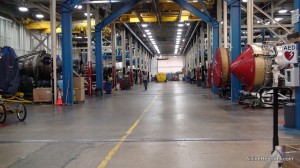
Delta Tech Ops has many engines worth millions of dollars each. Click for larger.
Delta flies many different aircraft types with a variety of engines. Down a long hallway are signs with different engine-types hanging from the ceilings (photo). Engines are located all all over the facility in different states of being repaired or overhauled.
Engines are very complex pieces of machinery composed of many different odd-shaped parts. Technicians need to be very careful of labeling each part to make sure they can put the engine-puzzle back together when completed (photo). When the composite fan blades are removed, they are stored separately and not allowed to touch (photo). Just be careful… each blade is worth about $20,000.00.
When the engine is done, it is moved into one of five test cells in the facility (photo). The test cell is a large wind tunnel and each engine will be run for about 8-12 hours to simulate a flight and to make sure it is ready to go back on an aircraft. After it gets the thumbs up, it is either placed on an aircraft waiting at the facility or packaged up and possibly shipped anywhere in the world for a customer (flight-line photo).
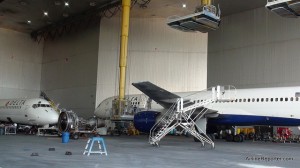
Delta's paint hangars have lifts come down from the ceiling (shouldn't they be called "lowers" then?). Click for larger.
The facility doesn’t just do engine work. They also work on anything from replacing small nuts and bolts, adding winglets and completing an overhaul of an aircraft. About 150 different companies will in-source maintenance at the TechOps center, meaning they keep busy.
Our next stop was taking a look at the paint hangars. They have been very busy recently with the merger with Northwest Airlines, getting all the planes painted over to Delta’s livery. I wasn’t able to see any Delta aircraft being painted, but I was able to check out a Hawaiian Airlines Boeing 767 that was in for a new coat of paint (photo). The hangars have lifts that come down from the ceiling to allow workers to efficiently paint aircraft. This saves time, since the painters are easily able to work around the aircraft with their mechanical lifts.
The Delta TechOps is one impressive place. Not only with the size of the facility, but the scale of their operations. Next time you are flying to ATL, be sure to take a look out the window and see if you can check out some of the action happening at the TechOps.
Check out more photos of the Delta TechOps.
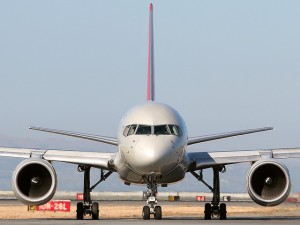
Northwest Airlines Boeing 757
There has been a lot in the news about airline mergers and buy outs. Delta & Northwest, United & Continental and most recently AirTran & Southwest. Some in the media throw around “merger” and “takeover” interchangeably, but they are very different. When two airlines come together, there are two types of sale agreements: the merger and the takeover.
I got an email from a reader (thanks Jay) asking about the difference between an airline merger and take over. I am not a financial professional, but I want to try my best to point out the major differences. If you have any more to add, please feel free to leave a comment!
MERGER:
This is when two companies come together blending their assets, staff, facilities, and so on. After a merger, the original companies cease to exist, and a new company arises instead. Sometimes the new entity will take the name and brand from one of the airlines, but sometimes an entirely new brand can be created.
Delta and Northwest merged, leaving the Delta brand. United and Continental merged, which will leave the United brand. In mergers like these, management needs to work hard to come to certain agreements, figure what/who will be cut and how the new airline will operate. Of course, this can be a very complex process for both airlines to undertake.
TAKE OVER / BUY OUT / ACQUISITIONS
In a takeover, a company is purchased by another company. The purchasing company owns all of the target company’s assets including company aircraft, trademarks, routes and so forth. The original company may be entirely swallowed up, or may operate semi-independently under the umbrella of the acquiring company.
In the case of Southwest buying out AirTran, the AirTran brand will disappear and be absorbed by Southwest. It is not a merger and Southwest will own the assets of AirTran and have complete control. This process is easier than a merger, since management at Southwest has the final say, but they need to successfully share their culture with the employees at AirTran and make sure they feel welcome.
Alright, I hope that helps some!
Image: fiveholer













